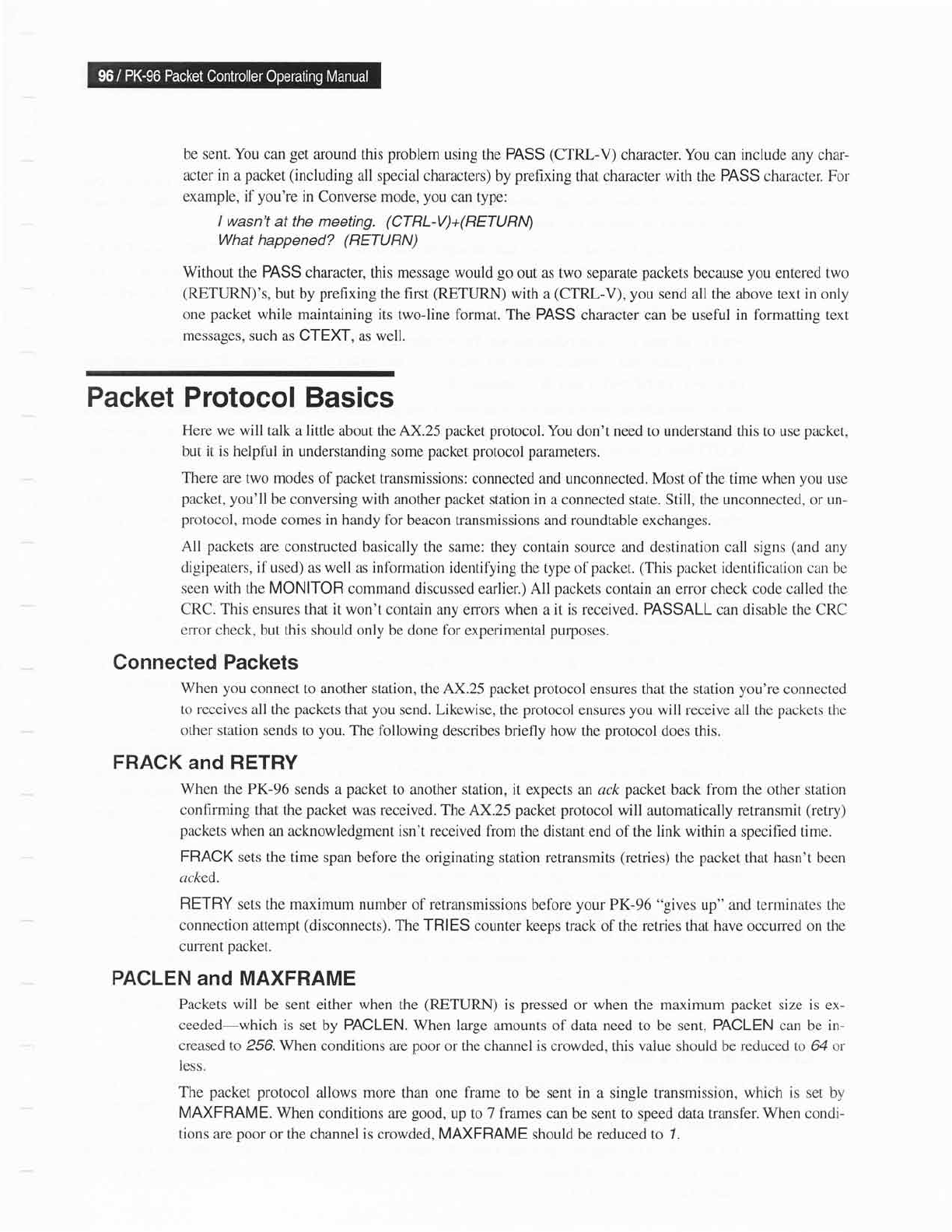Specifications
Table Of Contents

be sent.
You
can
get
around
this
problem
using the PASS
(CTRL-V)
character. You can include any char-
acter in a
packet
(including
all special characters)
by
prefixing
that character with the PASS character. For
example, if
you're
in
Converse mode,
you
can type;
I wasn't at the meeting.
(CTRL-V)+(RETURM
What happened?
(RETURN)
Without
the
PASS
character, this message would
go
out as two separate
packets
because
you
entered two
(RETURN)'s,
but
by
prefixing
the first
(RETURN)
with a
(CTRL-V),
you
send
all the above text
in
only
one
packet
while
maintaining its two-line format.
The
PASS
character can be useful in formatting text
messages, such
as CTEXT, as well.
Packet Protocol
Basics
Here we will talk
a little about the AX.25
packet protocol.
You don't need to understand this to use
packet,
but it is helpful in
understanding some
packet protocol parameters.
There are two modes
of
packet
transmissions:
connected and unconnected. Most of the time when
you
use
packet, you'll
be conversing with
another
packet
station in a connected state.
Still, the unconnected, or
un-
protocol,
mode
comes
in
handy for beacon transmissions
and
roundtable
exchanges.
All packets
are constructed
basically the same: they contain source and destination call signs
(and
any
digipeaters, if used) as well
as information identifying the type
ol
packet.
(This
packet
identiflcation
can be
seen
with
the MONITOR
command discussed earlier.) All
packets
contain an error check code called the
CRC.
This
ensures that it won't contain
any errors
when
a
it
is
received. PASSALL
can disable the CRC
crror check, but this
should only be done for experimental
purposes.
Connected Packets
When you
connect
to
another
station, the AX.25
packet protocol
ensures that the station
you're
connected
to
receives
all the
packets
that
you
send. Likewise, the
protocol
ensures
you will
receive all the
packets the
other station sends
to
you.
The fbllowing describes
briefly
how
the
protocol
does this.
FRACK
and RETRY
When
the PK-96 sends a
packet
to another station, it expects an ack
packet
back from the other station
confirming that the packet
was received. The AX.25
packet protocol
will
automatically retransmit
(retry)
packets
when
an acknowledgment isn't received
from the distant end of the link within a specified time.
FRACK
sets the time span
before the originating station retransmits
(retries)
the
packet
that hasn't been
acked.
RETRY sets
the
maximum
number of retransmissions before
your
PK-96
"gives
up" and terrninates
the
connection attempt
(disconnects).
The TRIES counter keeps
track of the
retries
that
have
occurred on
the
current
packet.
PACLEN
and MAXFRAME
Packets will
be sent either when the
(RETURN)
is
pressed
or
when the
maximum
packet
size
is ex-
ceeded-which
is set by PACLEN. When large
amounts of data need to be sent,
PACLEN
can be
in-
creased to 256. When conditions are
poor
or the channel
is
crowded, this value should be
reduced
to 64 or
tress.
The
packet protocol
allows more
than
one
frame to be sent in a single transmission, which is set by
MAXFRAME.
When conditions
are
good,
up to 7
frames
can be sent to speed data transfer.
When
condi-
tions are
poor
or the channel is
crowded,
MAXFRAME
should be reduced to 1.










